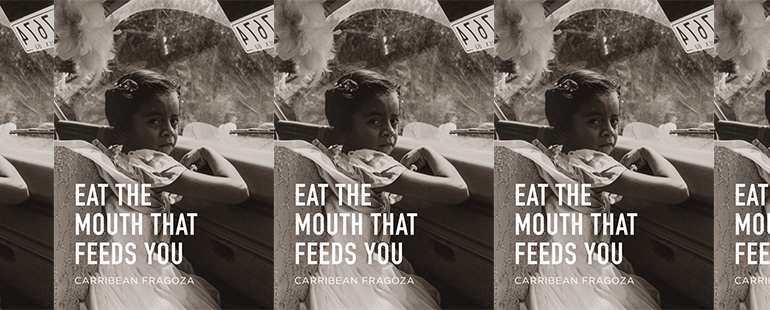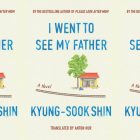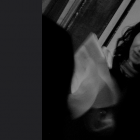Eat the Mouth That Feeds You by Carribean Fragoza

Eat the Mouth That Feeds You
Carribean Fragoza
City Lights | March 23, 2021
The stories in Chicanx writer and critic Carribean Fragoza’s debut collection oscillate somewhere between Laila Lalami’s depiction of multigenerational immigrant communities in the United States today, and María Fernanda Ampuero’s sharp, fable-like eye for horror when telling of violence against and by women. Entire lives unfold in just a few lines. Mothers guard and whisper their ancestral heritage to their daughters, hitting up against a history of abusive men who break their own homes. The female body becomes the shield and scythe that challenges patriarchal threat; sometimes it bleeds and sometimes it resuscitates from male brutality. But almost always female characters in Fragoza’s universe flex, chop, and levitate their way past men they no longer need. In ten tightly crafted stories, Fragoza presents a series of near-oral tradition narratives that lace vulnerability with strength and wounds with survival.
Wounds and survival are at the forefront in “Lumber Jack Mom,” as the narrator recounts how, after her abusive father leaves, her mother takes up chopping wood: “[Our mother] held that ax as naturally as if it were the hairbrush she’d used, until recently, to brush her hair out of a braid while she waited for our father.” As the pain of the past increases, so does her physical exertion. As the mother chops, the lime tree she and the father planted with the seeds they “lovingly smuggled” from Mexico stands in the background, symbolizing roots the family lay down upon their arrival to this country. Now, the tree bears no fruit, tangled and overgrown. The mother chops around this memory, literally, slicing everything but the lime tree, which looms in the garden, demanding she reckons with her past.
After a white-knuckle axing session, the daughter hugs her mother and feels “a large furry animal balled up, beathing slow but strong. It waited patiently to break out.” The abusive father is gone, but the mother and children remain in a cage of memory, regret, and pain. The mother’s physical reaction, seen through the daughter’s eyes, shows how trauma can paralyze families, the abuser’s ghost haunting like the lime tree in the yard.
The mother-daughter connection swells across Fragoza’s collection and takes center stage in the titular story. Ancestry flows through the mother’s body to the daughter’s, generations tethered together. Fragoza’s manner of telling obfuscates whether or not the daughter remains inside the mother or outside of her, sometimes pointing to both: “My daughter, for lack of memory, eats me . . . She must take from me what she needs.” Then later: “Over the years, she has eaten enough pencils and erasers, nibbled on wooden rulers . . . and has chewed on enough paper to create a beautiful blueprint.” Time, place, and body coalesce into a collective memory that reaches beyond this mother and daughter and into their ancestral past, readying the new generation for the present, the daughter carrying generations’ worth of traditions forward.
The daughter eating the mother also reverses the male Cronos myth (the father god that eats his sons to prevent succession) and distances itself from our modern gothic visual of Goya’s Saturn Devouring His Son. Carribean’s mythmaking pierces through her stories; mothers and daughters, symbolic or blood-related, share their histories and wisdom to protect each other. In “Eat the Mouth That Feeds You,” we see the mother slowly step back, out of her child’s way, her body and self beautifully emptied for her daughter. The cycle of wisdom-sharing repeats into the next generation.
This occurs in “Tortillas Burning” as well. The narrator wonders why she’d ever need her grandmother’s advice on all the different ways she could cook and save tortillas. We learn why later, as she makes the food last between herself and her son after escaping her abusive husband. Before escaping, the narrator shields her son from the father’s silver belt. “I crawled to [my son] and curled myself around his shivering little body, to muffle his cries with my bosom.” The mother protects and continues to give parts of herself, her body, to her child after he’s left the womb. These mother figures, rather than eat their young like Cronos or Saturn, protect and nurture life, and divert boys from becoming like their abusive, life-consuming fathers.
Finally, Fragoza plunges deeper into characters’ memories and the bodies that hold them, playing with the metaphysical in “Me Muero.” When a young woman dies, she experiences not just her own death but her family’s perception of it. The narrator goes from being observed on the back porch to doing the observing. Reminiscent of Chilean writer María Luisa Bombal’s “La amortajada,” where she lies in a casket and watches the men and women of her life lean in to say their goodbyes, Fragoza flips the narrative by animating both body and soul of the narrator as the young woman, limb by stiff limb, moves around the house.
“I decide to get up,” she announces after an uncle inspects her and rejoins the other men, joking about sports and drinking. But, as in life, so in death, some don’t (or won’t) engage her: “I see it happen all the time, someone will say something but no one will hear them, mostly because they didn’t really believe anyone would in the first place.” There’s melancholy here, a kind of disappointment (and commentary) that the status quo remains for women on both sides of the physical realm. The narrator in “Me Muero,” like many of the other women narrators, seeks her mother, the matriarch. But in this case, the daughter imparts the wisdom to the mother instead—how to die, what it’s like and what it’s not like; how to own your body’s last moments. She shares the gift of survival with the matriarch, possibly the one experience the mother could not yet give her daughter; it’s an ultimate sacrifice and reversal from the guardian mother figures that dominate the collection.
Fragoza imagines a world where patriarchy can be eradicated and finds beauty in how Chicanx women come together. In the end, her narrators, and the matriarchs they observe, choose who belongs in their circles, whether by blunt force or love.



